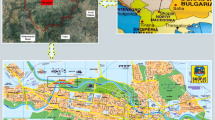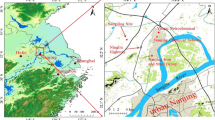Abstract
Purpose
To investigate the significance of sources around measurement sites, assist the development of control strategies for the important sources and mitigate the adverse effects of air pollution due to particle size.
Methods
In this study, sampling was conducted at two sites located in urban/industrial and residential areas situated at roadsides along the Brisbane Urban Corridor. Ultrafine and fine particle measurements obtained at the two sites in June–July 2002 were analysed by positive matrix factorization.
Results
Six sources were present, including local traffic, two traffic sources, biomass burning and two currently unidentified sources. Secondary particles had a significant impact at site 1, while nitrates, peak traffic hours and main roads located close to the source also affected the results for both sites.
Conclusions
This significant traffic corridor exemplifies the type of sources present in heavily trafficked locations and future attempts to control pollution in this type of environment could focus on the sources that were identified.



Similar content being viewed by others
References
Begum BA, Kim E, Biswas SK, Hopke PK (2004) Investigation of sources of atmospheric aerosol at urban and semi-urban areas in Bangladesh. Atmos Env 38(19):3025–3038
Buzcu-Guven B, Brown SG, Frankel A, Hafner HR, Roberts PT (2007) Analysis and apportionment of organic carbon and fine particulate matter sources at multiple sites in the Midwestern United States. J Air Waste Manage Assoc 57(5):606–619
Cuccia E, Bernardoni V, Massabò D, Prati P, Valli G, Vecchi R (2010) An alternative way to determine the size distribution of airborne particulate matter. Atmos Env 44(27):3304–3313
Friend AJ, Ayoko GA (2009) Multi-criteria ranking and source apportionment of fine particulate matter in Brisbane, Australia. Environ Chem 6(5):398–406
Friend AJ, Ayoko GA, Elbagir SG (2011a) Source apportionment of fine particles at a suburban site in Queensland, Australia. Environ Chem 8(2):163–173
Friend AJ, Ayoko GA, Stelcer E, Cohen D (2011b) Source apportionment of PM2.5 at two receptor sites in Brisbane, Australia. Environ Chem 8(6):569–580
Gu J, Pitz M, Schnelle-Kreis J, Diemer J, Reller A, Zimmermann R, Soentgen J, Stoelzel M, Wichmann HE, Peters A, Cyrys J (2011) Source apportionment of ambient particles: comparison of positive matrix factorization analysis applied to particle size distribution and chemical composition data. Atmos Env 45(10):1849–1857
Han JS, Moon KJ, Lee SJ, Kim YJ, Ryu SY, Cliff SS, Yi SM (2006) Size-resolved source apportionment of ambient particles by positive matrix factorization at Gosan background site in East Asia. Atmos Chem Phys 6(1):211–223
Kasumba J, Hopke PK, Chalupa DC, Utell MJ (2009) Comparison of sources of submicron particle number concentrations measured at two sites in Rochester, NY. Sci Total Environ 407(18):5071–5084
Kim E, Hopke PK (2004) Comparison between conditional probability function and nonparametric regression for fine particle source directions. Atmos Env 38(28):4667–4673
Kim E, Hopke PK, Edgerton ES (2003a) Source identification of Atlanta aerosol by positive matrix factorization. J Air Waste Manage Assoc 53(6):731–739
Kim E, Larson TV, Hopke PK, Slaughter C, Sheppard LE, Claiborn C (2003b) Source identification of PM2.5 in an arid northwest US city by positive matrix factorization. Atmos Res 66(4):291–305
Kim E, Hopke PK, Larson TV, Covert DS (2004) Analysis of ambient particle size distributions using unmix and positive matrix factorization. Environ Sci Technol 38(1):202–209
Lee JH, Hopke PK (2006) Apportioning sources of PM2.5 in St. Louis, MO using speciation trends network data. Atmos Env 40(Supplement 2):S360–S377
Lee E, Chan CK, Paatero P (1999) Application of positive matrix factorization in source apportionment of particulate pollutants in Hong Kong. Atmos Env 33(19):3201–3212
Lighty JS, Veranth JM, Sarofim AF (2000) Combustion aerosols: factors governing their size and composition and implications to human health. J Air Waste Manage Assoc 50(9):1565–1618
Lippmann M (2009) Semi-continuous speciation analyses for ambient air particulate matter: an urgent need for health effects studies. J Expo Sci Env Epidemiol 19(3):235–247
Lippmann M, Chen L-C (2009) Health effects of concentrated ambient air particulate matter (CAPs) and its components. Crit Rev Toxicol 39(10):865–913
Mauderly JL, Chow JC (2008) Health effects of organic aerosols. Inhalation Toxicol 20(3):257–288
Mazzei F, Lucarelli F, Nava S, Prati P, Valli G, Vecchi R (2007) A new methodological approach: the combined use of two-stage streaker samplers and optical particle counters for the characterization of airborne particulate matter. Atmos Env 41(26):5525–5535
Moon KJ, Han JS, Ghim YS, Kim YJ (2008) Source apportionment of fine carbonaceous particles by positive matrix factorization at Gosan background site in East Asia. Environ Int 34(5):654–664
Morawska L, Johnson GR, He C, Ayoko GA, Lim MCH, Swanson C, Ristovski ZD, Moore M (2006) Particle number emissions and source signatures of an industrial facility. Environ Sci Technol 40(3):803–814
Morawska L, Ristovski Z, Jayaratne ER, Keogh DU, Ling X (2008) Ambient nano and ultrafine particles from motor vehicle emissions: characteristics, ambient processing and implications on human exposure. Atmos Env 42(35):8113–8138
NEPC (1998) National environmental protection (ambient air quality) measure. National Environmental Protection Council, Adelaide
NEPC (2003) Variation to the national environment protection (ambient air quality) measure for particles as PM. National Environment Protection Council, Adelaide
Ogulei D, Hopke PK, Wallace LA (2006a) Analysis of indoor particle size distributions in an occupied townhouse using positive matrix factorization. Indoor Air 16(3):204–215
Ogulei D, Hopke PK, Zhou L, Patrick Pancras J, Nair N, Ondov JM (2006b) Source apportionment of Baltimore aerosol from combined size distribution and chemical composition data. Atmos Env 40(Supplement 2):S396–S410
Ogulei D, Hopke PK, Chalupa DC, Utell MJ (2007a) Modeling source contributions to submicron particle number concentrations measured in Rochester, New York. Aerosol Sci Technol 41(2):179–201
Ogulei D, Hopke PK, Ferro AR, Jaques PA (2007b) Factor analysis of submicron particle size distributions near a major United States–Canada trade bridge. J Air Waste Manage Assoc 57(2):190–203
Paatero P (1997) Least squares formulation of robust non-negative factor analysis. Chemom Intell Lab Syst 37(1):23–35
Paatero P, Tapper U (1994) Positive matrix factorization—a nonnegative factor model with optimal utilization of error-estimates of data values. Environmetrics 5(2):111–126
Pope CA III, Burnett RT, Thun MJ, Calle EE, Krewski D, Ito K, Thurston GD (2002) Lung cancer, cardiopulmonary mortality, and long-term exposure to fine particulate air pollution. J Amer Med Assoc 287(9):1132–1141
Reff A, Eberly SI, Bhave PV (2007) Receptor modeling of ambient particulate matter data using positive matrix factorization: review of existing methods. J Air Waste Manage Assoc 57(2):146–154
Ristovski ZD, Wardoyo AYP, Morawska L, Jamriska M, Carr S, Johnson G (2010) Biomass burning influenced particle characteristics in Northern Territory Australia based on airborne measurements. Atmos Res 96(1):103–109
Schlesinger RB (2007) The health impact of common inorganic components of fine particulate matter (PM2.5) in ambient air: a critical review. Inhalation Toxicol 19(10):811–832
Song XH, Polissar AV, Hopke PK (2001) Sources of fine particle composition in the northeastern US. Atmos Env 35(31):5277–5286
Sun J, Zhang Q, Canagaratna MR, Zhang Y, Ng NL, Sun Y, Jayne JT, Zhang X, Zhang X, Worsnop DR (2010) Highly time- and size-resolved characterization of submicron aerosol particles in Beijing using an aerodyne aerosol mass spectrometer. Atmos Env 44(1):131–140
Thimmaiah D, Hovorka J, Hopke PK (2009) Source apportionment of winter submicron Prague aerosols from combined particle number size distribution and gaseous composition data. Aerosol Air Qual Res 9(2):209–236
Thomas S, Morawska L (2002) Size-selected particles in an urban atmosphere of Brisbane, Australia. Atmos Env 36(26):4277–4288
Wahlin P, Palmgren F, Van Dingenen R (2001) Experimental studies of ultrafine particles in streets and the relationship to traffic. Atmos Env 35(Supplement 1):S63–S69
Yue W, Stoelzel M, Cyrys J, Pitz M, Heinrich J, Kreyling WG, Wichmann HE, Peters A, Wang S, Hopke PK (2008) Source apportionment of ambient fine particle size distribution using positive matrix factorization in Erfurt, Germany. Sci Total Environ 398(1–3):133–144
Zhou L, Kim E, Hopke PK, Stanier CD, Pandis S (2004) Advanced factor analysis on Pittsburgh particle size-distribution data. Aerosol Sci Technol 38(Supplement 1):118–132
Zhou L, Hopke PK, Stanier CO, Pandis SN, Ondov JM, Pancras JP (2005a) Investigation of the relationship between chemical composition and size distribution of airborne particles by partial least squares and positive matrix factorization. J Geophys Res-Atmos 110(D7):D07S18/01–D07S18/14
Zhou L, Kim E, Hopke PK, Stanier C, Pandis SN (2005b) Mining airborne particulate size distribution data by positive matrix factorization. J Geophys Res-Atmos 110(D7):D07S19/01–D07S19/15
Zhu Y, Hinds WC, Kim S, Shen S, Sioutas C (2002) Study of ultrafine particles near a major highway with heavy-duty diesel traffic. Atmos Env 36(27):4323–4335
Author information
Authors and Affiliations
Corresponding author
Additional information
Responsible editor: Euripides Stephanou
Electronic supplementary material
Below is the link to the electronic supplementary material.
ESM 1
(DOCX 1405 kb)
Rights and permissions
About this article
Cite this article
Friend, A.J., Ayoko, G.A., Jayaratne, E.R. et al. Source apportionment of ultrafine and fine particle concentrations in Brisbane, Australia. Environ Sci Pollut Res 19, 2942–2950 (2012). https://doi.org/10.1007/s11356-012-0803-6
Received:
Accepted:
Published:
Issue Date:
DOI: https://doi.org/10.1007/s11356-012-0803-6




